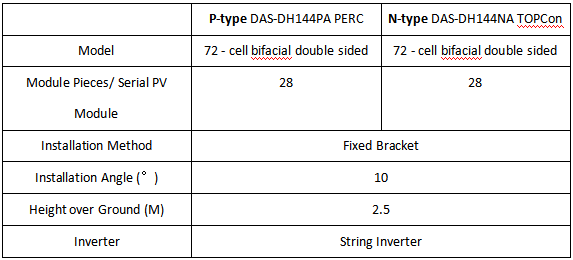DAS Solar N-type module gain of 5.22% for Hainan PV plant
2023-11-27
With the successful grid connection at the end of 2022, the Hainan PV plant project, which has the N-type and P-type modules supplied by DAS Solar, has once again achieved a remarkable gain of 5.22%.
Its tropical monsoon maritime climate keeps Hainan warm all year around, with an average temperature of 24 degrees Celsius, rainfall of 1,400 mm, and total solar irradiance of 1,500 kWh / m2, the sufficient solar resources provide a natural advantage for the operation of PV plant. The state-enterprise-owned PV plant in Hainan which installed the bifacial TOPCon double glass modules and bifacial PERC double glass modules supplied by DAS Solar, reaches its DC side total installed capacity to 100MW. In the comparison programme of power generation gain, both N-type and P-type modules adopt the layout of 28 pieces of modules for a string, ensuring the best performance for specific working conditions. In addition, every 17 or 18 strings of modules are connected to a 196KW string inverter, and every 16 string inverters are converged into a 3.15MW box transformer. By comparing the power generated by N-type and P-type modules which is under the same design and installation conditions, the specific statistics can be acquired to better evaluate and optimize the Hainan PV plant.

PV plant design parameters
Based on the statistics from December 2022 to September 2023, N-type TOPCon modules demonstrate a notable average increase in power generation of 5.22% under same installed capacity, surpassing the power output of P-type PERC modules under similar conditions.

During the empirical testing, DAS Solar's N-type modules has shown its outstanding quality: first years degradation not exceed 1% and annual degradation less than 0.4% which is far less the 2% first year power degradation and 0.45% annual degradation of P-type modules. With lower power degradation, the N-type module's power generation gains over the P-type module will also increase each year, from 1% in the first year to 2.45% in the 30th year, resulting in an approximate 1.73% power generation gain over the module's entire life cycle.
In addition, the temperature coefficient is key factor for the power generation especially in the summer while the temperature coefficient of the N-type modules is -0.30%/°C resulting a 11.76% lower overall temperature than that of the P-type modules which leads to a better performance.
The average operating temperature of N-type modules in adjacent positions is about 2°C lower than that of P-type modules. Meanwhile, due to higher cell efficiency, N-type modules are able to convert more light into electricity, which greatly reduces the loss of power generation in high-temperature conditions.
DAS Solar's N-type bifacial double-glass modules not only has higher front-side power generation efficiency, but also has a substantial increase in rear-side power generation gain. DAS Solar's N-type modules reaches a bifaciality rate up to 80%, surpassing P-type modules by 14.3%, which have a bifaciality rate of 70%. While the P-type’s back-side energy generation reaches 10%, DAS Solar's N-type will be 11.43% in identical installation conditions enhancing the PV plant's power benefits by the 1.4% more electricity generated by each module.
Through the above comparison on statistics, DAS Solar’s TOPCon module can realize 3%-5% increase in power generation gain for its excellent low power degradation, low-temperature coefficient and high bifaciality comparing to P-type modules. In the future, DAS Solar will continues to innovate in the field of N-type technology, providing customers with more stable and reliable but also profitable full-scenario PV solutions which contribute the further the development of renewable energy.






 浙公网安备33080302000236
浙公网安备33080302000236